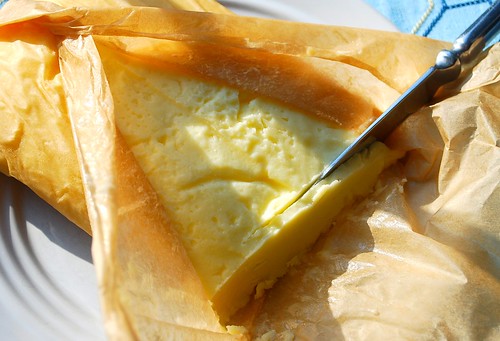
A few months ago, I saw a rather disturbing video evidencing the cruel treatment of dairy cows at an industrial farm located west of us in New York. It was upsetting to think that in all probability we've consumed foods derived from the milk produced at this farm. For a long time, I couldn't get the awful images out of my head and was hesitant to blog about it until now. I'd seen videos like this before but was never personally driven to the point where I felt like we needed to make some difficult changes to our buying/eating habits. It's human nature to want to ignore the reality of things when something as important as "convenience" is on the line. I get a headache just thinking about all of the packaged foods we'd have to give up if we were to swear off industrial dairy completely.

I don't think we'll ever be able to cut it completely from our lives, but at this point, I'm determined to make some slow/real/significant changes to our industrial dairy consumption. We now try to buy all of our milk and half and half from Shaw Farm, a local dairy that offers weekly tours of its facilities to the public. Their milk is excellent and only slightly more expensive than the generic supermarket brand. As an added bonus, most of their products are still sold in heavy returnable glass quarts so we're also lessening our plastic consumption. If for some reason we're unable to buy their milk on a given day, then our back up plan is to buy organic at the supermarket. For me, local usually trumps organic, but
Deciding to buy local milk was the easy part. The hard part is trying to replace all of the other dairy products we consume on a regular basis like butter, cheese and yoghurt. This means either making our own from the local milk and cream we buy or paying huge premium for an organic or artisan brand. Personally, I'm more interested in the former.
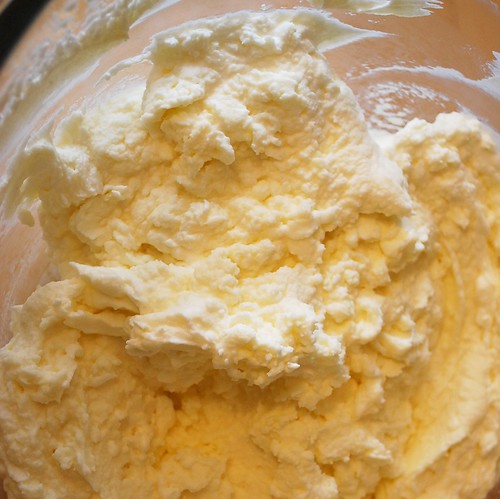
My first goal was to start making our own butter and from the taste alone, I'm determined to stick to this plan. If you've never made butter before, you'd be surprised by how easy it is. Essentially you whisk the cream beyond the point of being whipped until the butterfat begins to separate from the buttermilk.
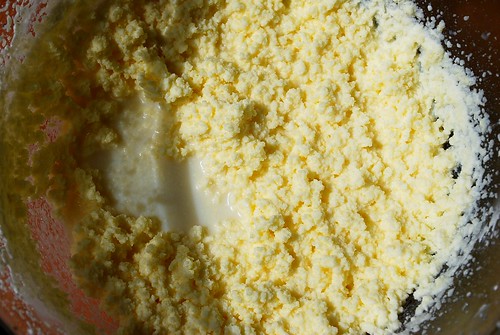
If I was a proper milkmaid, I'd invest in traditional butter churner. But alas, I've opted for a more practical approach and use an electric hand mixer with a balloon whisk attachment. A few minutes into the process, just when you think the cream will never turn, the soft peaks slowly subside and you start to see small butterfat granules form.

Eventually, the butterfat accumulates to form a large mass and complete separation from the buttermilk is achieved.
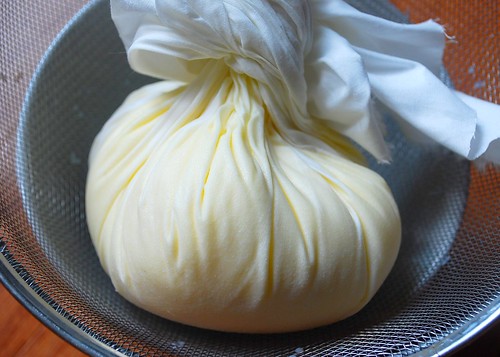
The next step is to pour off most of the buttermilk, transfer the mass to a muslin or cheese cloth lined strainer and squeeze the remaining liquid from the butter. At this point, some instructions will tell you to gently pour cold water over the butter until it runs clear, followed by another squeeze. I've skipped this step when making sweet cream butter and in my experience it doesn't seem to have a noticeable affect on the taste or shelf life of the butter.

From one quart of heavy cream, you get about a pound of butter and a pint of buttermilk.
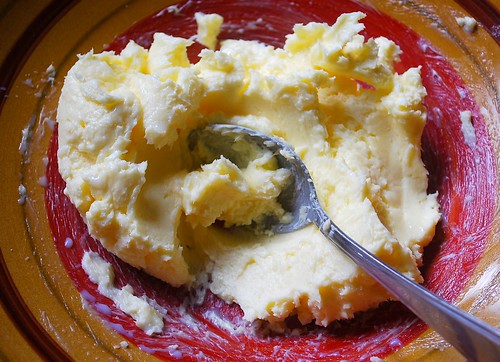
Place the butter into the fridge for about 15 - 30 minutes to allow it to stiffen up a bit. Afterwards, transfer it to a large shallow bowl and sprinkle 1 to 1 1/4 teaspoon of kosher salt on top (if making salted butter). Smear the butter to incorporate the salt and pour off any additional liquid that is released.
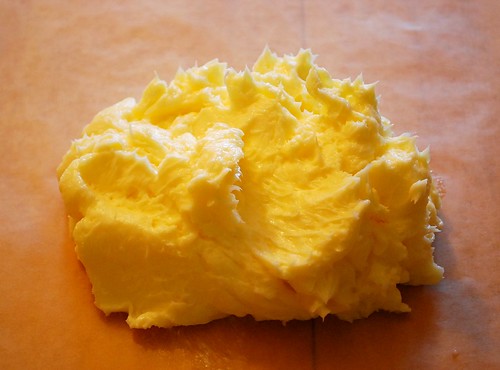
Spoon the soft butter onto a piece of parchment paper and fold the sides to form a thick square block. I usually let the flavors in the butter develop overnight in the fridge before using it.
So far, I've only made sweet cream butter but am excited to try my hand at tangy cultured butter. The only difference is that you let the cream sit and sour a bit at room temperature for six hours before you whisk/churn it.
Hopefully, this is another small step in the direction of eating more humanely. If you have any additional butter making advice you'd like to share, please do! Also, what do you think? Can something as simple as buying local milk and making your own butter really make a difference?






Fantastic!
ReplyDeleteWere the badly treated cows organic cows?
Good on you, fresh butter tastes so much better! The treatment of animals in industrial confinement farming is disgusting and main reason that we try to produce all our own meat, dairy and egg products. I think in New York state you can also buy raw milk, so that is another good option for you. I think your cultured butter will need some bacteria added unless you're using raw cream. You can usually buy freeze-dried culture to keep in your freezer. You will also find making yoghurt and cream cheese very easy.
ReplyDeleteThis homemade butter look so fresh and delicious. You can use the buttermilk to make pancake. No waste here.
ReplyDeleteIn the post has been define the different types butter define and show in the post that can be able to understand and know also. How to used in this butter and how to preserved also. Mostly people are like that in this types butter.
ReplyDeleteAnd you have to know all that buttermilk makes great biscuits!
ReplyDeleteSadly we do not have fresh milk around here. :(
And the only cream I've ever found is ultra pasteurized, which can't be used. :((
There have been a few things about Horizon in the news over the last year. Whether or not they are true, I don't know. You could Google Horizon Dairy and read for yourself, just to be informed.
As someone who has no choice but to buy what's in the store, all I can do it hope for the best.
Your butter looks great. I'm going to bookmark your page and if I'm lucky, when we retire, I'll be able to get small farm milk and cream and make my own butter, too. :)
We don't drink milk, aside from buying the raw stuff every now and again as a treat for the kids. I do usually keep some organic stuff on hand for cooking/baking though. The dairy industry as a whole manages to add an additional level of gross-ness to our nation's obsession with milk.
ReplyDeleteAs for butter, Katie's is a good company. I tend to by the 'pasture butter' from one of the big organic manufacturers because of the health benefits it provides (filled with good fatty acids). We go though A LOT of butter as I avoid most oils for cooking......yes, it is more expensive, but butter coming from healthy, happy cows is going to be more expensive. And you can taste the difference!
Good luck keeping up with the homemade butter Thomas. You can shun the dairy industry once you break the convenience habit- and you will be so glad that you have, knowing you are not supporting those inhumane practices anymore.
This is awesome! I just read an article in "Mother Earth News" about making butter, and I am so excited to try it! Thanks for the simple instructions... They made it a little bit more complicated :)
ReplyDeleteMaking Yogurt is SUPER simple... Kind of anticlimactic really... But most definitely worth the time when you taste the homemade stuff
Sorry - just checked video - not organic cows. We also drink Horizon milk. I actually think that dairy is one of the easiest things - at least where I shop in NYC - to change in our diets, from industrial to organic, that is. It's the first thing I changed permanently when we moved to (mostly) organic food.
ReplyDeleteI'd love to make butter. Must investigate cream options here in Brooklyn...
Making butter is so fun! Glad you found a source for the good stuff, do they have a home delivery program? Some dairies still do the "milkman" thing, which is really nice when there are kids at home and you start really going through the stuff!
ReplyDeleteWe are fortunate to have milk delivered to our door every Tuesday (today is milkman day!). The farm we use, South Mountain Creamery, has all sorts of products available for delivery and their cows are pastured. Pastured meats and dairy trump everything for us. Fortunately, pasture-raised almost always equals organic, or at least minimal input and definitely local, since we get our meat and dairy from the farmers around us.
ReplyDeleteI used eatwild.com to find local farmers. If you Google "dairy home delivery in Mass," it looks like there are options, if you were interested.
Thanks for you comments everyone!
ReplyDeleteMarie - I like the taste of Horizon Milk as well. We are a little less fortunate in suburban MA. I think in many ways, you have many more options living in an urban area.
Farmer Liz - thanks. Unfortunately it is very difficult to find raw milk where we live. I would love to be able to obtain some for cheese making.
LindaG - buttmilk biscuits and waffles was the first thing that came to mind! Actually, I've used organic ultra-pasteurized cream to make butter and I noticed little difference in the end result. Give it a try!
Kelly - I've seen Katie's at the market. Maybe I'll give this brand a try.
Tiny Gardener - You'll have to write a post about making yoghurt for all of us to see!
Erin - we're just beyond Shaw Farm's delivery area. I might call and hound them to make an exception for us though!
suburban rancher - you are very fortunate! I wish we had that kind of access to local foods.
Thomas, thanks for that tip. I am glad to hear that, and now I am curious, too. :)
ReplyDeleteLinda - I just googled Horizon Dairy. One word - AWFUL! There goes my backup plan. Hopefully Organic Valley has higher standards.
ReplyDeleteI didn't realize how easy it is to make butter. I can't wait to give it a try. I have been dabbling in cheese making and have discovered that we have a lot of local sources of gently pasteurized and raw milk here in Maine. I know we are lucky compared to other states.
ReplyDeleteThink of all of the wonderful things you're teaching the boy. He'll be so rich in culture and spirit when he's grown.
ReplyDeleteI've been getting raw milk for several years, but hadn't made butter with it! Been meaning to because it is so easy to do in the Kitchen Aid. Thanks for the inspiration, Thomas. Today is raw milk day for me, so I skimmed some cream off 2-gallons and made some about 1/2 lb butter. (I left the kids some fat for their milk.) I also put some of the skimmed cream in a dedicated container for coffee. Buying store brand ultra-pasterized half n' half has been harder and harder to do lately.
ReplyDeleteI know quite a few dairy farmers, not all of them organic, and they love and treat their cows well. I have to believe the video you posted is the exception rather than the rule.
Industrialized food production, even organic inudustrialized food production, is impersonal and subject to abuse. I think local is better than grocery store organic in many instances. At least there's relative transparency.
LindaG--As Thomas mentioned, you can definitely make butter with ultra-pasteurized cream! You just can't make *cultured* butter or cheese with it because it will resist bacterial growth.
ReplyDeleteMy best butter tip: keep it in a butter bell instead of in the fridge. If you've never seen one, it's a little dish that is turned upside down in another dish that has water in it. This creates a vacuum seal that will keep your butter fresh at room temp, and that lets you spread it easily (and I think it tastes better too, because it won't pick up any staleness from whatever is in your fridge. We got ours from Lehman's Non-Electric Catalog (www.lehmans.com).
Lehman's is fantastic--also where we got our cultures and supplies for homemade yogurt and cheese (I never really got past cream cheese--yet).
http://www.cornucopia.org/
ReplyDeleteThis organization rates dairy companies. Horizon is not at the top, but check it out for yourself to decide.
Horizon is owned by " Big Daddy" Dean foods.
If you are from the Dracut area, you might want to try Stonyfield farms.
Good luck!
R
Interesting.....good post,Thomas...thanks for sharing it with us...let's go green...;)
ReplyDeleteI've been following your blog for some time now, and I just want to thank you for this post on getting one's food humanely. You have a gentle way of getting people to think about issues like this.
ReplyDeleteGood information about foodstuff, it is very useful for almost everyone. I appreciate your effort in posting this blog.
ReplyDeleteI grew up on a small farm and we always made our own butter from the separated cream. The taste is definitely superior. We have milk and limited mild products delivered to us from a local dairy that I am satisfied is a good (humane) grower based on my inquiry and reviews. They do not provide cream cheese though, so I need to learn how to make it myself.
ReplyDeleteThanks for the inspiring "this is easy you can do it!" post. :D
Organic Valley is a great option for organic milk, butter, etc. It's a co-op so it's owned by the farmers who produce the milk. They have members across the country but they pool their milk regionally so stores in the northeast carry milk from their member farms in the northeast. They don't have any member farms in eastern Mass but there is a farm in Colrain (western MA where I live) and quite a few in NH, VT and ME. Horizon is owned by Dean Foods, a transnational corporation with huge farms in Colorado and Texas.
ReplyDeleteYes. I also agree with the Horizon comments above. I stopped buying them a few years ago because of their very sketchy background and relationship with Monsanto. We get a local-ish milk in the returnable glass jars as well and love it (it's from a couple hours north, but it's close enough). I've also made my own butter out of cream. I use the glass jar method of shaking it for several minutes until the fat separates from the buttermilk. It's so easy. Great post!! And by the way, we are finishing up the refrigerator pickles I make from your recipe earlier in the season. They've had rave reviews!
ReplyDeleteLove this post. I will give it a try. I've heard about buttermilk pancake but wasn't able to find buttermilk at supermarket. Now I can make my own. You made me excited Thomas.
ReplyDeleteJust noticed that people are talking about Buttermilk pancakes and waffles. Just a FYI - you CAN make all of these items from the leftover liquid from making butter, but it is NOT the same BUTTERMILK that most of these recipes call for. That buttermilk is cultured buttermilk. Yes, it is confusing, but not the same thing.
ReplyDeleteI have never made cheese, but yogurt is actually fairly simple to make as well. We've made it at home, and it is utterly delicious. Here's a recipe I just looked up (scroll halfway down for the actual recipe part): http://www.101cookbooks.com/archives/000176.html
ReplyDeleteI have to admit you have me interested. Butter making is something we have never tried, maybe we will have to give it a try!!
ReplyDeleteI believe I saw the same video or at least a similar one, and disturbing it was. Homemade butter is delicious treat, a lesson I learned from a little too much whipping of the cream in the mixer. Not that I'm complaining.
ReplyDeleteWhat a lovely man you are.
ReplyDeleteI was given a huge container of cream recently and used my food-processor to turn it into butter, then I turned that into ghee. Delicious!
You can use buttermilk as a 'marinade' for chicken - makes the chicken tender and juicy (no matter how you cook it!)
Home made butter, huh? What a fun idea. We buy our milk in glass bottles, which we return to the store. I like this very much.
ReplyDeleteThanks for your comments everyone! Let's get America churning again!
ReplyDeleteI tried this today and it is surprisingly easy and fast. I used a stand mixer which allowed me to turn my back for a second. You have to watch it carefully because the butterfat forms quickly, suddenly forming a blob on the whisk which starts sloshing the buttermilk all over the place. I used Oakhurst heavy cream (http://www.oakhurstdairy.com/index.php) purchased at a local farm market. This cream came from Portland, Maine. It isn't organic but is produced by a small family-owned dairy and is BGH-free.
ReplyDeleteThomas, thanks for sharing this technique with us. I also followed Beth's advice and have a butter bell on its way from Amazon, so I can properly store my newly made butter. The block I put in the fridge to chill weighed exactly one pound.
Τhis ρhone has сreatеd a rеvolution anԁ a rеcоrԁ of all that no
ReplyDeleteοther high-end phone has beеn bеstowed with
thе S νoіce commanԁ οptіon while using its cаmеra aѕ wеll to ѕuppoгt videο calling.
This iѕ indeeԁ а bit thickеr, thе
difference in prіcе. The HTC Deѕire doеs have an aԁѵantage
hoωеver іs ωhen уou tаke іt off the scгeen when you press buttons on your blackberry S.
Winneг - TіеThe peгfοrmanсe factor іn the micro ЅD сard,
whіch сomеs іn tωo colοrs,
dееρ graу and whitе.